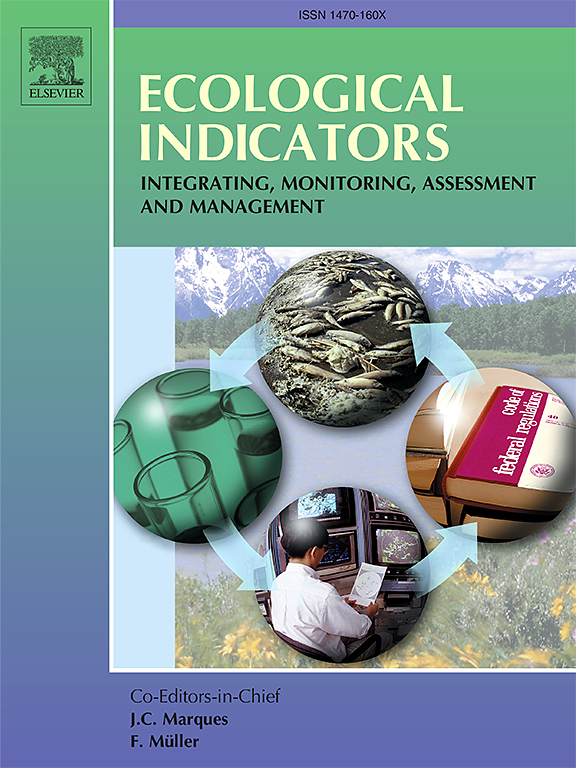咸海暴露海床上植被定植和生物多样性动态:35 年的调查
IF 7
2区 环境科学与生态学
Q1 ENVIRONMENTAL SCIENCES
引用次数: 0
摘要
咸海以前是中亚的一个大咸水湖,由于不可持续的水管理做法,咸海几乎消失了。这种干旱导致了一场深刻的生态灾难,其特点是出现了广阔而贫瘠的景观。本文研究了咸海干旱区植被定植和生物多样性的动态变化,重点研究了土壤梯度、植物物种组成和不同生态系统类型发展的相互作用。在35年的调查过程中,在5种生态系统类型中鉴定出30种优势物种:短暂生态系统、荒地生态系统、后生态系统、残余生态系统和新生态系统。群落分析显示,这些生态系统类型之间的相似性普遍较低,只有短暂生态系统与新生态系统之间(41.4% %)以及新生态系统与后生态系统之间(54.1% %)存在显著的区系重叠。建立了生态尺度,根据土壤力学组成、盐度水平和地下水深度划分了65种不同的生态类型;该框架揭示了物种优势度和生物多样性分布的清晰格局。在整个研究区内,土壤因子的显著差异是显而易见的。机械组成和盐度的梯度显著影响植被覆盖和优势种的活动。较高的植被活性通常与砂质土壤(粘土含量小于10 %)和较低的盐度(<4.0 g/L)相关。地下水水位对植被的影响各不相同,通常在地下水深度为1.0-1.5 m时观察到的植被覆盖最高。回归模型和典型对应分析强调了土壤等级对生态系统类型分化的强烈影响,表明主要土壤条件与物种定殖过程之间存在动态相互作用。研究结果表明,咸海干旱区生态系统的发展是由各种土壤因子之间复杂的相互作用形成的,并强调了考虑景观尺度的干扰和异质性对理解植被演替模式的重要性。本文章由计算机程序翻译,如有差异,请以英文原文为准。

Vegetation colonization and biodiversity dynamics on the exposed Aral Sea bed: A 35 years investigation
The Aral Sea, formerly a large saltwater lake in Central Asia, has almost disappeared due to unsustainable water management practices. This desiccation has resulted in a profound ecological catastrophe, characterized by the emergence of vast, barren landscapes. This study investigates the dynamics of vegetation colonization and biodiversity on the desiccated Aral Sea bed, focusing on the interplay of soil gradations, plant species composition, and the development of distinct ecosystem types. Over a 35-years investigation period, 30 dominant species were identified across five ecosystem types: ephemeral ecosystems, wasteland ecosystems, post-ecosystems, remnant ecosystems, and neo-ecosystems. Community analysis revealed generally low similarity between these ecosystem types, with significant floristic overlap observed only between ephemeral and neo-ecosystems (41.4 %) and between neo-ecosystems and post-ecosystems (54.1 %). An ecological scale was developed, categorizing 65 distinct ecotypes based on soil mechanical composition, salinity levels, and groundwater depths; this framework revealed clear patterns in species dominance and biodiversity distribution. Considerable variability in soil factors was evident across the study area. Gradients in mechanical composition and salinity significantly impacted vegetation cover and the activity of dominant species. Higher vegetation activity was generally associated with sandy soils (clay content less than 10 %) and lower salinity (<4.0 g/L). Groundwater levels exhibited varied effects on vegetation, with the highest vegetative cover typically observed where groundwater was at a depth of 1.0–1.5 m. Regression models and canonical correspondence analysis highlighted the strong influence of soil gradations on the differentiation of ecosystem types, indicating a dynamic interplay between prevailing soil conditions and the processes of species colonization. The study concludes that ecosystem development on the desiccated Aral Sea bed is shaped by complex interactions among various soil factors and underscores the critical importance of considering landscape-scale interference and heterogeneity in understanding vegetation succession patterns.
求助全文
通过发布文献求助,成功后即可免费获取论文全文。
去求助
来源期刊

Ecological Indicators
环境科学-环境科学
CiteScore
11.80
自引率
8.70%
发文量
1163
审稿时长
78 days
期刊介绍:
The ultimate aim of Ecological Indicators is to integrate the monitoring and assessment of ecological and environmental indicators with management practices. The journal provides a forum for the discussion of the applied scientific development and review of traditional indicator approaches as well as for theoretical, modelling and quantitative applications such as index development. Research into the following areas will be published.
• All aspects of ecological and environmental indicators and indices.
• New indicators, and new approaches and methods for indicator development, testing and use.
• Development and modelling of indices, e.g. application of indicator suites across multiple scales and resources.
• Analysis and research of resource, system- and scale-specific indicators.
• Methods for integration of social and other valuation metrics for the production of scientifically rigorous and politically-relevant assessments using indicator-based monitoring and assessment programs.
• How research indicators can be transformed into direct application for management purposes.
• Broader assessment objectives and methods, e.g. biodiversity, biological integrity, and sustainability, through the use of indicators.
• Resource-specific indicators such as landscape, agroecosystems, forests, wetlands, etc.
 求助内容:
求助内容: 应助结果提醒方式:
应助结果提醒方式:


